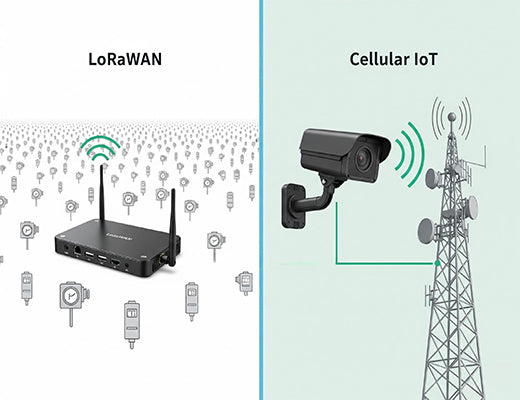
LoRaWAN vs Cellular IoT: Which is Right for Your Industrial Application?
|
|
Time to read 5 min
|
|
Time to read 5 min
When it comes to connecting your industrial assets, two powerful wireless technologies dominate the conversation: LoRaWAN and Cellular IoT (like NB-IoT, LTE-M, and 5G). But they are designed for very different jobs.
This guide provides a clear, in-depth LoRaWAN vs Cellular IoT comparison. We'll break down the fundamental differences in network ownership, range, power consumption, bandwidth, and cost.
By the end, you'll have a clear framework to help you decide which technology is the perfect fit for your specific industrial application.
I often get asked a simple but crucial question by engineers starting a new wireless project: "Should I use LoRaWAN or cellular?" The answer is almost always, "It depends." Choosing the wrong technology is a costly mistake. I've seen projects fail because they chose power-hungry cellular for a battery-powered sensor that only needed to send a tiny packet of data once a day. I've also seen projects fail because they chose LoRaWAN when they needed the high bandwidth to stream video.
The LoRaWAN vs Cellular IoT debate isn't about which is "better"; it's about which is the right tool for the job. They are both excellent technologies, but they are optimized for completely different tasks. This guide will give you the knowledge to make that strategic choice with confidence.

Before we get into the technical specs, the most important difference in the LoRaWAN vs Cellular IoT discussion is how you access the network.
This single difference has massive implications for cost, coverage, and control.
Let's break down the key technical differences to better understand the LoRaWAN vs Cellular IoT choice.
Feature |
LoRaWAN |
Cellular IoT (NB-IoT/LTE-M) |
Cellular IoT (4G/5G) |
Primary Use Case |
Massive, low-power sensor networks |
Low-power asset tracking & metering |
High-bandwidth, low-latency applications |
Network Model |
Private (You deploy gateways) |
Public (Carrier-owned) |
Public (Carrier-owned) |
Range |
Excellent (Up to 10+ km) |
Good (Relies on cell tower density) |
Good (Relies on cell tower density) |
Power Consumption |
Very Low (Years on battery) |
Low (Months/Years on battery) |
High (Requires mains power) |
Bandwidth |
Very Low (Bytes per message) |
Low (Kilobytes per message) |
Very High (Megabits/Gigabits) |
Cost (Per Device) |
Low (No SIM/data plan) |
Medium (Requires SIM & data plan) |
High (Requires SIM & data plan) |
Best For |
Smart agriculture, smart buildings, utility metering |
Smart meters, asset trackers, smart city sensors |
CCTV, in-vehicle connectivity, remote machinery |

You should choose LoRaWAN when your application involves:
You should choose Cellular IoT when your application involves:
The LoRaWAN vs Cellular IoT decision doesn't have to be complicated. It comes down to a simple analysis of your application's needs. If you need to connect a massive number of low-power, low-data devices in a concentrated area and want to own your network, LoRaWAN is the clear winner. If you need to connect a smaller number of high-bandwidth or highly dispersed devices and can leverage existing public infrastructure, Cellular IoT is the way to go. By understanding their fundamental strengths, you can confidently select the technology that will make your industrial IoT project a success.

A1: Yes, absolutely! A very common and powerful architecture is to use a LoRaWAN gateway that has a cellular backhaul connection. The gateway uses LoRaWAN to talk to the local sensors and then uses a 4G or 5G cellular connection to send the aggregated data to the cloud.
A2: NB-IoT (Narrowband IoT) and LTE-M (LTE for Machines) are two specific types of Cellular IoT technologies designed for low-power, wide-area (LPWAN) applications. They offer better battery life and lower costs than traditional 4G/5G but provide less bandwidth. They are direct competitors to LoRaWAN but operate on the licensed cellular spectrum.
A3: It depends on the scale. For a single device, a cellular connection might be cheaper upfront as you don't need to buy a gateway. However, for a deployment with hundreds or thousands of sensors in one area, LoRaWAN is almost always far more cost-effective in the long run because you avoid paying for thousands of individual SIM card subscriptions.